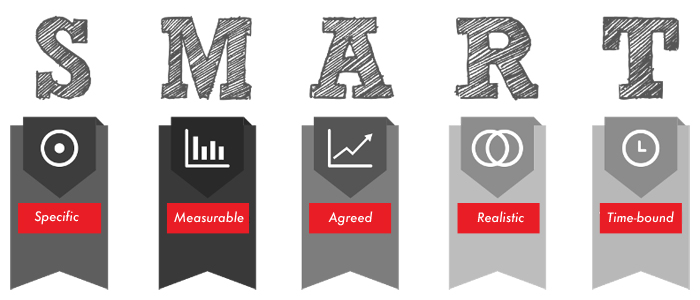Creating clear, measurable objectives and holding others to account for them is one of the most important practical skills of a leader. There is a real skill to capturing clearly and precisely the essence of what needs to be achieved, while making sure it is easily measurable – and that the measures and standards you use are the right ones.
“Setting goals is the first step in turning the invisible into the visible.”
Tony Robbins
A useful guide is to remember the acronym SMART. Your objectives should be:
Specific, Measurable, Agreed, Realistic, Time-bound
A SMART objective must be objectively measurable and/or observable – anybody should be able to see and agree that it has been achieved.
Easy objectives to set are those which address numerical targets:
- Achieve fee income of £xxx, by (date), with x% write-off rate.
- Make xxx prospect calls and set up xxx well-qualified meetings during (time period).
- Sign up xxx new clients in our target markets during (time period).
- Achieve budget of £xxx by (date).
- Reduce costs by x% by (date)
- Develop and test client survey by (date). Administer to xx clients by (date). Report due by (date).
- Achieve client satisfaction of 75% or above on client survey during (time period).
- Reduce the backlog of enquiries from xx to yy by (date).
Other objectives may address in-department projects, personal development needs and day-to-day behaviours. Agree measures with the job holder; you may need to be creative to ensure that the objective is objectively (ie by someone other than you!) measurable and/or observable.
Use clear descriptive statements of the ideal outcome or behaviour you are aiming at:
- Improve accountability in my team this (time period).
Measured by: improved quality of work (% right first time, number of trivial errors); supervision level reduced with no loss of quality (managerial time spent in hours/minutes); stakeholders are happy (director satisfaction, client satisfaction etc.)
- Improve perception of self this year from one of resistance and lack of interest; accept feedback willingly.
Measured by: unsolicited feedback (number of instances); formal review (manager and colleagues); 360 degree feedback
- Improve meeting of deadlines in my team.
Measured by: improved quality of work (% right first time, number of trivial errors etc.); deadlines missed (target = 0); time freed to focus on other tasks (time freed up in hours/minutes).
- Develop a new process to ensure regular contact with long term clients by (date).
Measures: no client goes longer than xx months without personal contact; no clients missed; every client has face to face contact at least every x years; client feedback; new business from long-term clients
You can see that to produce these more qualitative objectives, you need to be creative and think really hard about what the meaningful measures are. A common mistake is to fall back on crudely quantifiable numbers, but these often aren’t a meaningful measure of what you are really after.
For example, when I started as a company training manager in my early career, my initial set of measures, given to me by my manager, were:
- Number and frequency of training courses per year
- Number and level of employees trained
- Number and variety of courses attended per employee
- Scores obtained on the end-of-course evaluation survey
Are these really a meaningful measure of how effectively I was doing my job? Not really. By the time I left the company a few years later, the measures were:
- Agreed learning objectives met (these were agreed between participants and their managers before the training programme)
- Changes in participants’ behaviour
- Feedback from participants’ managers, immediately following the training and 6 months and one year on
- Improvements in participants’ measurable results (ie they met or exceeded their own performance objectives as a result of the training)
- All stakeholders’ satisfaction (measured by asking them!)
All these standards are not as easy to measure as the crudely quantifiable list above, but they are a much more accurate read out of how effectively I was doing my job as training manager.
Some hints:
- If you know quality work when you see it, then there is a set of criteria you are using. You may not be consciously aware of it, nor immediately able to articulate it, but it is there.
- With sufficient rigour, you can always come up with a list of clearly observable or measurable behaviour or result statements.
- Don’t fall into the trap of using crude numerical measurements just because they are easier.
Would you like to read more of the same? Then click on the graphic below to sign up to our regular newsletter.

